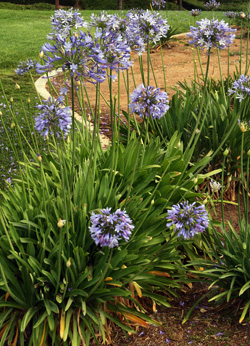Mastering the Art of Agapanthus Treatment: Necessary Actions for Healthy Development and Lively Flowers
In the world of gardening, the growing of agapanthus stands as a rewarding endeavor for those that seek to nurture these stylish blooming plants. From selecting the right selection to understanding pruning methods, the trip towards growing prospering agapanthus plants is complex and holds the crucial to opening the full capacity of these agricultural gems.

Choosing the Right Agapanthus Range

When picking the right Agapanthus variety for your garden, think about factors such as environment suitability, bloom color, and development habit. Additionally, think about the environment in your area to make certain the Agapanthus variety you pick can flourish in your certain problems. Comprehending the development habit of different Agapanthus selections is critical for appropriate placement within your garden.
Suitable Planting Problems
Considering the optimal environmental needs is necessary for successful Agapanthus cultivation. Agapanthus plants are delicate to cold temperatures and must be shielded from frost throughout wintertime months.
To guarantee healthy and balanced development and vibrant blossoms, plant Agapanthus bulbs at a deepness of about 2-4 inches and room them 8-12 inches apart. Mulching around the base of the plants helps preserve dampness and subdues weed growth.
Watering and Fertilizing Tips
Preserving proper dampness levels and supplying important nutrients are crucial elements in the treatment regimen for Agapanthus plants. It is vital to strike an equilibrium when it comes to watering Agapanthus. These plants favor constantly moist soil however are susceptible to root rot if overwatered. Throughout the expanding period, water deeply as soon as a week, making sure the dirt is well-draining to avoid waterlogging. In hotter environments or throughout periods of dry spell, even more frequent watering may be necessary to keep the soil evenly damp. Nevertheless, minimize watering in the winter to avoid water logged conditions.
Feeding Agapanthus is important for promoting healthy and balanced growth and prolific blooms. Apply a balanced plant food, such as a 10-10-10 formula, in the very early springtime as brand-new growth arises. Repeat this application every 6-8 weeks throughout the growing season. Avoid too much fertilization, as it can bring about lush vegetation at the cost of blooms. Constantly comply with the producer's directions for correct dilution and application techniques. By following these watering and additional info feeding ideas, you can guarantee your Agapanthus plants flourish and produce dynamic, lasting blossoms.
Trimming Strategies for Agapanthus
Pruning Agapanthus plants at the suitable times and with proper methods is crucial for maintaining their health and promoting optimal growth and flowering. The ideal time to prune Agapanthus remains in late winter months or early springtime before new growth emerges. Begin by eliminating any type of dead or yellowing fallen leaves near the base of the plant. Cut them as close to the ground as possible without harming the emerging shoots.
For flowered stems, wait till the flowers have perished and then trim them back to the base. This not only cleans the plant's look but also encourages the growth of new flower buds. Deadheading spent flowers can additionally reroute the plant's power into generating even more blooms instead of setting seeds. Nevertheless, if you wish to collect seeds for propagation, leave some flowers to mature and completely dry on the plant.
Remember to make use of tidy, sharp tools to make precise cuts and minimize the threat of presenting conditions. Agapanthus. Routine trimming will certainly help maintain your Agapanthus looking neat and healthy while making certain a plentiful screen of attractive blossoms
Handling Usual Insects and Illness
After ensuring appropriate trimming techniques for Agapanthus, it is necessary to resolve common pests and illness that can influence the wellness and vigor of find here these plants. One usual parasite that influences Agapanthus is the Agapanthus gall midget.
Another usual concern is fungal fallen leave spot, which offers as dark sores on the fallen leaves. To avoid fungal illness, ensure great air blood circulation around the plants, avoid above watering, and remove any contaminated leaves promptly. Additionally, Agapanthus plants can experience root rot if they are grown in inadequately draining pipes soil. To stop this, plant Agapanthus in well-draining soil and stay clear of overwatering. By being attentive and taking timely action versus bugs and diseases, you can assist your Agapanthus plants prosper and create lively blooms.

Conclusion
To conclude, understanding the art of agapanthus care involves picking the right variety, supplying perfect planting problems, appropriate watering and feeding, proper pruning strategies, and resolving common insects and diseases. By following these necessary steps, you can make certain healthy growth and lively blooms for your agapanthus plants. Remember to regularly keep track of and preserve your plants to promote their general well-being and durability.
To ensure healthy and balanced development and dynamic blossoms, plant Agapanthus light bulbs at a depth of regarding 2-4 inches and room them 8-12 inches apart. By following these watering and fertilizing ideas, you can ensure your Agapanthus plants prosper and generate vibrant, long-lasting flowers.
One common bug that influences Agapanthus is the Agapanthus gall try this site midge. In addition, Agapanthus plants can endure from root rot if they are planted in poorly draining pipes soil. By adhering to these vital steps, you can make sure healthy and balanced development and lively blooms for your agapanthus plants.